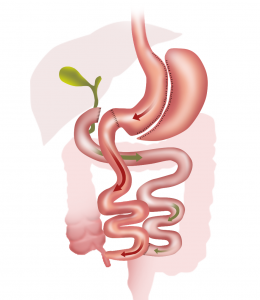Biliopancreatic Diversion with Duodenal Switch (BPD-DS) surgery, a modification of BPD surgery, combines a sleeve gastrectomy (removal of part of the stomach) with a long intestinal bypass.
Surgical Procedure
- In the sleeve gastrectomy, part of the surgery, the outer margin of the stomach is removed, leaving a banana-shaped stomach, ¼ of its original capacity, that remains connected to the duodenum.
- This creates a restrictive portion of the surgery. The surgeon accomplishes this by dividing the first part of the duodenum between the stomach and bile duct and closing of the divided end.
- The surgeon then divides the small intestine about halfway down, connecting the lower portion to the open end of the duodenum. This segment is referred to as the digestive, or roux, limb.
- The remaining end of the small intestine is reconnected 75-100 cm from the large intestine creating the “common channel” allowing for bile and pancreatic juices to flow and mix with the food at the distal end of the small intestine, instead of in the duodenum, thereby limiting the absorption of nutrients and calories.

Advantages of BPD-DS Surgery
- Quick and dramatic weight loss
- Excellent long term weight loss results
- Less restriction in diet compared to bypass
- Able to eat larger portions of food than “pouch” surgeries
- Pyloric valve is left intact minimizing “Dumping Syndrome”
- Normal stomach function is maintained but in a smaller capacity
- Reduced incidence of stomach ulcers due to the removal of most of the acid-secreting cells in the stomach
- Continued weight loss for 18-24 months post-surgery
- Many patients maintain a weight loss of 75-80% of excess weight 10 years post-op
- Improved health problems associated with severe obesity (ie. Diabetes, high blood pressure, sleep apnea, etc.)
- Improved mobility and quality of life
Disadvantages of BPD with duodenal switch surgery
- Most complicated of currently available obesity surgeries
- A limited number of surgeons performing this procedure via laparoscopy
- Longer recovery time, usually 6-8 weeks
- Potential for protein malnutrition - Malnourishment and anemia may occur requiring life long vitamin and mineral supplementation
- Malabsorptions require life long supplementation of fat-soluble vitamins (A, D, E, and K), B12, calcium, and iron
- Life long follow up with physician required
- Risk of iron deficiency, anemia, and osteoporosis if supplements not taken
- Increased risk of gallstones due to rapid weight loss- Requires gallbladder removal during surgery due to high risk of gallstones
- Not possible to fully reverse due to partial removal of the stomach
- Increased stool frequency
- Foul flatulence and diarrhea if fatty foods are eaten
- Risk of hair loss
Risks & Complications
As with any surgery, there are potential risks involved. The decision to proceed with the surgery is made because the advantages of surgery outweigh the potential disadvantages. It is important that you are informed of these risks before the surgery takes place. Most patients do not have complications after Gastric Bypass BPD-DS surgery; however, complications can occur and depend on the patient’s health status. Complications can be medical (general) or specific to Gastric Bypass BPD-DS.
Medical complications include those of the anesthesia and your general well-being. Almost any medical condition can occur, so this list is not complete. Complications include:
- Allergic reaction to medications
- Blood loss requiring transfusion with its low risk of disease transmission
- Heart attack, strokes, kidney failure, pneumonia, bladder infections
- Complications from anesthesia
- Serious medical problems can lead to ongoing health concerns, prolonged hospitalization, or occasionally death. (Less than 1% cases)
Specific complications of Gastric Bypass BPD-DS include:
- DVT (blood clot in the deep leg veins)
- Damage to adjacent organs especially spleen, pancreas, and bile duct
- Abdominal hernia
- Leakage of digestive contents can lead to serious infection (Peritonitis)
- Leakage of digestive contents from the staple line can lead to serious infection
- Stricture (narrowing) of the opening between the stomach and small intestine
- Dumping Syndrome: Vomiting, reflux, and diarrhea caused by stomach contents moving too rapidly through the small intestine
- Abdominal hernias
- Gallstones
- Dehydration
- Bleeding ulcers of the stomach
- Intolerance to some foods
Register for a Seminar
Other Metabolic & Bariatric Surgery Procedures
- Robotic Assisted Bariatric Surgery
- Virtually Scarless Surgery
- Biliopancreatic Diversion with Duodenal Switch Surgery
- Laparoscopic Gastric Bypass
- Sleeve Gastrectomy
- Adjustable Gastric Banding
- Intragastric Balloon
(Nonsurgical Procedure) - Revisional Bariatric Surgery
- Band Over Bypass
- Adolescent Bariatric Programs








